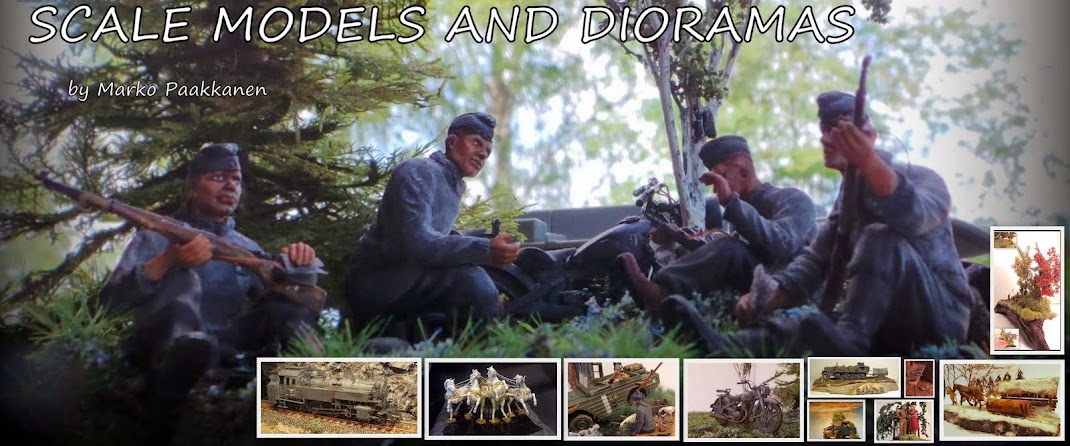Abandoned Mig
I’ve always wanted to try to build a
heavily weathered, bare metal aircraft. I had Tamiya’s Mig 15 Bis Clear edition
sitting on my shelf for years, gathering dust. It was probably one of the first
kits I purchased when I took up this hobby 3 or 4 years ago but I never really
took to.
With no specific strategy in mind for the
paintwork I pressed on with the build stages and wasn’t disappointed with the
usual Tamiya fit and finish. The outer fuselage was particularly well moulded
but did lack some finer detail.
I purchased some “Rosie the Riveter” wheels
to add further rivet details on the fuselage and while waiting for them to
arrive I bashed on with the cockpit. This was a basic affair out of the box so
I set about applying the science of “gizmology” or “ adding bits of old parts
and sprue to make it look sort of appropriate and more detailed”.
Parts laid out and ready to assemble
Cockpit up-detailed with a spot of
“gizmology”
Cockpit dry fit into fuselage
In addition to the cockpit I also added the
de-humidifying pipes and scratched up a more believable gunsight from sprue and
old parts I had lying around.
Then the cockpit got a spot of paint and
weathering to represent an old and well worn workplace. This, of course, was
all pretty much a waste of time as the canopy would be fogged from age,
obscuring all the details inside. At least I’ll know it’s there right?
Painted cockpit installed. Belts were paper prints from a
photoshop master I created.
The kit comes with a nicely detailed engine. However, I
didn’t want to depict the Mig split in half in this instance so elected to tack
the front and rear fuselage halves together so I can go back and do the engine
some real justice in the future.
The nicely detailed jet engine won’t be
seen.
Once the major elements were prepped it was
time for final assembly. The canopy was masked and smaller parts, like landing
gear, fuel tanks and nose cowling, were set aside for painting later..
Final assembly.
There are many reference images available
on the net for abandoned aircraft but I was looking to create something that
showed off the look of old aluminium metal rather than the usual depictions in
models of shiny bare metal with variegated panel shades.
I found the below pic and thought it might
be possible to get close.
Reference pic of an old Polish Mig.
I used Titanium paint over a Mr Surfacer
1200 primer which was lightly sanded back for a smooth base. The rosie riveter
tools also arrived so I set about adding rivet lines in appropriate places,
with a spot of guesswork too.
Tamiya’s titanium enamel paint.
Sadly I didn’t take any step by step pics
of the actual paint and weathering stages as I get so involved in the process
that I often forget. It is also pretty difficult to remember exactly what steps
and sequences I applied the different mediums used.
The titanium basecoat was spotted with
medium sea grey enamel applied with a sponge and then rubbed over with dark
pigments. This was then sealed with klear and the number decals added. These
were then weathered with sanding sticks and scalpel to create the chipped worn
effect. After resealing the decals I then added a lighter overspray of titanium
mixed with white and a touch of buff.
Then the panel lines and rivets received a
thin wash of AK Interactive’s engine grime, followed by a delicate brush over
with dark pigments. This was then resealed with a matte varnish ready for more
filters and washes. I also used an overall dark wash with Flory products and
this was left to dry for a few days.
Once the washes were fully dried I began to
rub back some of the flory wash with a dampened Q-tip to get some streaking in
the lower fuselage. This was accentuated with further streaks of AK’s engine
grime applied with a thin brush. Further details were added with the AK engine
grime around rivet and panel lines and subtle use of the AK slimy green wash
was used to create small areas of algae build up.
Partially complete weathering.
Final steps included using some green chalk
powder to add some green tinges to the wing surfaces and tail uprights and then
the front cowling received an overspray of light blue acrylics which was then
chipped back with water for the old paint look.
AK Interactive rust washes were added
around the canopy frames and panel lines and the whole build received a final
coat of Matte varnish.
The finished build was placed on a simple
pre-made ground cover sheet, glued to a cut MDF base.
Here’s the final pics, the first of which
was a simple photoshop overlay on a suitably stark background. Hope you like.




























